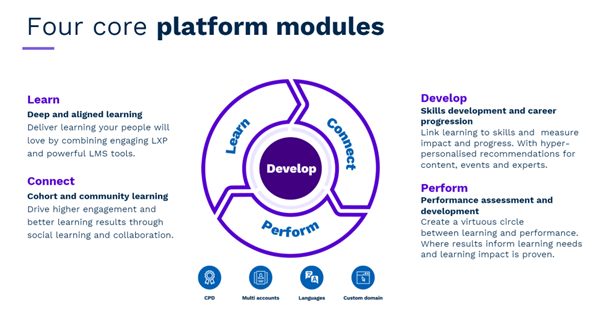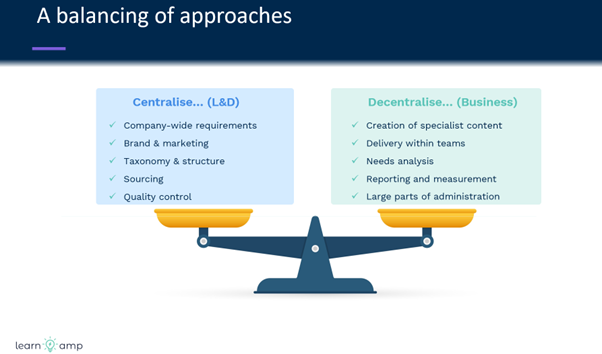In her Learn Amp review, Laura found a powerful, all-in-one people development platform that offers all the key features of LMS, LXP, social learning and performance management software.
It combines learning management, upskilling & career development, employee engagement and performance reviews into one easy to use solution.
Learn Amp is a mid-market “Swiss Army knife” of a platform, which elegantly solves a multitude of problems for employee-focused organisations and supports individuals to learn in the context of their career.
Learn Amp offers Learn, a highly configurable and easy to administrate learning platform with a clean and intuitive UX and Develop to aid skills development and career progression.
To amplify the employee value proposition, they have Connect for sophisticated community and social tools, and Perform to support skills development, objective setting, and performance reviews.
A “people development platform”
Learn Amp like to think of their platform as a “people development platform” – one that will help businesses and organisations to retain great talent. They believe that the four pillars of the employee experience – learning, development, engagement, and performance – are intrinsically linked and should work together to retain that talent.
To help achieve this they have four products on offer, each one designed to develop one of these pillars:
- Learn – their LMS / LXP
- Develop – their skills development and progression tool
- Connect – their suite of social learning tools
- Perform – performance reviews, objective setting, and skills development tools to track skills across your business.
To complement these products, they also offer additional bolt-ons for CPD, multi-accounts, languages, and custom domains.
Learn Amp’s customer base is concentrated in the mid-market (although they have customers with as few as 250 employees and their biggest to date has around 45k, so they can easily manage scale) and internal use cases for employee-focused organisations. An important exception is training and coaching for external learning communities, such as customer or partner communities.
They are very much focused on career management, motivating people through what matters most in their lives, with recognition and progression, and developing in a way that’s aligned to their career aspirations and purpose.
With their focus on helping employees develop their career, Learn Amp is certainly a vendor that should be on your long list if you’re an organisation in their sweet spot of 500 – 5,000 employees and with an L&D strategy to improve performance. They are often best when replacing a previous system, where more educated buyers who have a better understanding of what they need have outgrown their previous solutions and recognise the extra value that Learn Amp can bring.
I would also add that Learn is an excellent LMS / LXP hybrid, combining the ease of everything you would expect from an LMS with the high-end UX and content delivery of an LXP.
Designed to promote motivational career development
A key mission statement for Learn Amp is “learning in the context of your career”, enabling their clients to really support individuals with whatever skills they need. This emphasises their focus on the employee use case.
Perhaps unusually amongst learning solution providers, Learn Amp are not huge fans of gamification. They have previously described it as being all a bit “gimmicky”, and instead would rather focus on designing tools that intrinsically motivate people, which creates more sustainable long-term engagement.
They often talk about the “science and soul of learning”, and by this they mean the idea of developing the tools to motivate individuals through progression and recognition, which are aligned to their own purpose and meaning. Their big question is always, “how do you connect with what actually motivates people to learn?”
They do have leaderboards, which is something that one could argue is a gamification tool. However, their persuasive counterpoint to this is that these are for motivating employees through recognition and enabling learning with peers, rather than tools to shame employees into greater productivity.
Their concept of a “Hierarchy of Engagement” is very interesting, a kind of learning version of Maslow’s “Hierarchy of Needs”, with the LMS as the base layer, and it is really focused on helping organisations to amplify their employee value proposition as they increase their learning culture maturity.
Their Connect suite of social learning tools has a huge amount of different touch points and includes a feature best described as an internal LinkedIn. Individuals can have profile pages, follow and connect with SMEs, mentors, and thought leaders in your organisation, upload user generated content, and engage in communities that can be fully open or controlled based on the use case and need.
A “Swiss Army knife” of a solution
Learn Amp pride themselves on trying to understand a problem and then building very flexible solutions that not only meet that immediate need, but also lots of others, and this can be seen by the fact that their platform is being utilised and used in a wide variety of different sectors.
Clients in a highly regulated space with a focus on compliance and CPD want an LMS, but because they are forward-thinking, they recognise that Learn Amp will provide them with the future proofing that they need. These might include industries like financial services, cybersecurity, construction, architecture, and professional services.
Then you also have their products in businesses where knowledge transfer is essential and compliance is much more of a secondary concern. For example, involving more of a bottom-up knowledge transfer approach utilising all that user generated content, and this might include organisations like management consultancies, advertising agencies and organisations in the engineering, computer software, and gaming sectors etc.
These tend to be attracted by the idea of how Learn Amp can help them create a culture of organic learning, where individuals and communities drive each other’s development instead of it being a more top-down approach.
Learn Amp provide a high degree of configurability and flexibility around widgets. There is a vast number of different widgets on offer that can be pulled into a large number of different dashboards to suit the needs of varied audiences.
Not only is this a versatile solution to meet the needs of different organisations and the varied audiences within them, but also brilliant for change management and allowing organisations to introduce things at a sensible pace, and evolving and scaling whilst also future proofing their needs.
They like to say that you can almost build your system pretty much bespoke to meet your current needs wherever you are in your journey and maturity. You can turn lots of things off to keep it simple to begin with, safe in the knowledge that your needs are future proofed.
Another USP is the consolidation benefit of having an all-in-one solution that might enable organisations to dispose of other systems and not have so many. For example, the Connect module is great for enabling the delivery of internal comms and setting up and sending out surveys on a large scale.
It also enables a lot of different touch points for people to interact with SMEs, comment on content, and to interact with each other and in the community area.
The Pioneers of “Software with a Service”
Learn Amp were the first to coin the term, “Software with a Service” (or SWAS), which means they are not only extremely focused on implementing the best software solution for their clients, but also giving them the guidance and coaching to ensure its implementation and adoption is a success.
So interestingly all their internal roles are in effect “coaches”. For example, Sales Solution Coaches, Customer Success Coaches etc.
This very collaborative partnership approach with their clients is a huge USP for them and has been witnessed by Learn Fox during LMS selection processes. They don’t provide a “managed service” as such, which would mean doing everything for the client or even administrating their system.
Instead, they offer what they describe as a “supported self-serve” model, as they believe ownership must ultimately rest with the customer who has the knowledge of their own business, but they are there to provide very hands-on expert industry advice throughout the journey.
The people employed into the Learn Amp team do all tend to have a background in L&D or education, so this enables them to provide a very supportive consultancy focus. I think a retention rate of around 96% speaks for itself.
Features to aid a “decentralised” learning strategy
Learn Amp’s products enable organisations to deploy a decentralised learning strategy, allowing individual teams to have more ownership over their own content and administrative processes. They believe this is critical for modern organisations trying to best adapt to the major changes that have resulted from hybrid and remote working models.
It is so much harder to train and coach now, as not everyone is in the same space. So, their answer is a more inverted model which is employee and manager led and L&D supported.
This can also save huge amounts of time and admin for L&D so that they can focus on higher value work and deliver more impact with less resource. This is most obviously shown through their admin and authoring experience.
With the admin experience, the first thing that stands out is that there is no separate admin console, or a separate area that administrators have to go into and create and design things before pushing them out and then logging in to see how they look. Instead, it is completely integrated, so that if you have admin rights you can simply open a little admin pop up menu (by clicking the 3 pips on a particular object) that enables you to edit and interact with content and items within the platform on whatever page you are on.
Very little training is needed, meaning that lots of different SMEs, trainers, or other people across the business can undertake admin tasks in the platform. To enable this ease of use, their aim has been to produce tools that are “consumer grade” – the kind of tools that might be familiar to users in their day to day lives, like Spotify for example.
Learn Amp don’t have an inbuilt elearning authoring tool and they don’t pretend to have authoring capability, which is another example of their philosophy of being very focused on the things they do best, rather than spreading themselves too thinly. What they do offer however are in-built micro-authoring capabilities and a huge wealth of functionality that enables the creation of pages, surveys, and modulated learning content very much in the format one would expect from a SCORM file.
They provide an easy page builder as well as video and audio creation tools and the ability to create short form content. All this plays into the decentralised strategy because you’re not limited to a small team using an external authoring tool.
Instead these tools are intuitive and easy to use, which means that in theory anybody in the organisation, like SMEs or trainers, could easily create their own content. They don’t have to be learning designers or have learning development skills.
Focus on what they do best – and partner for the rest
Learn Amp have always been focused on what they do best, and they believe they are a “best in breed” platform, with a “best in breed” learning ecosystem of partners that compliment them and integrate seamlessly. They are not an elearning authoring tool, they are not content producers, not a talent management suite or an ERP, and they don’t try to be.
Instead, what they do have is a suite of tools (Learn, Develop, Connect and Perform) that solve a whole host of problems for many organisations. Additionally, they also have a variety of really good content partners – niche providers like Pluralsight and Udemy for Business, some all-in-one offerings for small to medium businesses like iAM Learning and GoodHabitz, and good consolidated aggregated content providers like Go1 (and coming soon, OpenSesame).
So not only do they provide brilliant solutions via their own software, but they partner where they need to, not just for content but also with other tools and consultants who can help to provide that software with a service approach that they pride themselves on.
The Learn Amp Roadmap
Learn Amp are very transparent and open about what they are trying to develop, and they are always responsive to the requirements and needs of their client base. This is amply demonstrated through them making their product Roadmap available.
Some of the new features highlighted by their Roadmap include 360 feedback, a new addition to their suite of performance tools, while praise and recognition functionality (shout-outs) is being brought into their suite of social tools. They also have a new BI tool enabling the conversion of data sources to provide trends and insights and visualised analytics.
Managers can already create their own dashboards, which is a great USP for the decentralised strategy, but with the BI tool this will enable administrators to create more complex and sophisticated visual analytics for different audiences.
Being a “future focused” vendor means that Learn Amp are also spending time considering how best to harness the power of generative AI. Examples might include the addition of a coaching tool, a search assistant, or a form of content creation.
They are also exploring the idea of generating a live dynamic skills taxonomy that never goes out of date.
In Summary
If you’re looking for an all-in-one solution to deliver all the features you’d expect from LMS, LXP, social learning and performance management software, then in Learn Amp – you’ve found it.
Rather than simply rolling out training materials en masse, Learn Amp is about motivating employees to learn for their own professional development, and encouraging peer to peer knowledge sharing through its social learning tools.
By leveraging the latest training technologies and layering on the potential of generative AI, it provides a future-proof employee engagement and learning platform that can scale up with you as your people and organisation grow.
Learn more about this great solution over on the Learn Amp website.
Please note: When conducting product or service reviews, our consultants are paid by the vendor for their time spent reviewing the solution and writing their findings and opinions.
However, this does not give the vendor influence on the content of that review or how we then showcase it on our website or external channels. On the occasions where we feel a solution is not of a quality we would like to showcase at Learning Light, we have offered this feedback to the vendor and not published a review.
While we may draw attention to the strengths, ideal user-type and use-cases of an elearning company, we encourage all buyers to conduct a thorough training needs analysis and to do the necessary due diligence during vendor screening as part of their procurement process.
We can provide experienced consultancy with this, from initial needs analysis to full RFP management, via our independent elearning consultancy services.

























